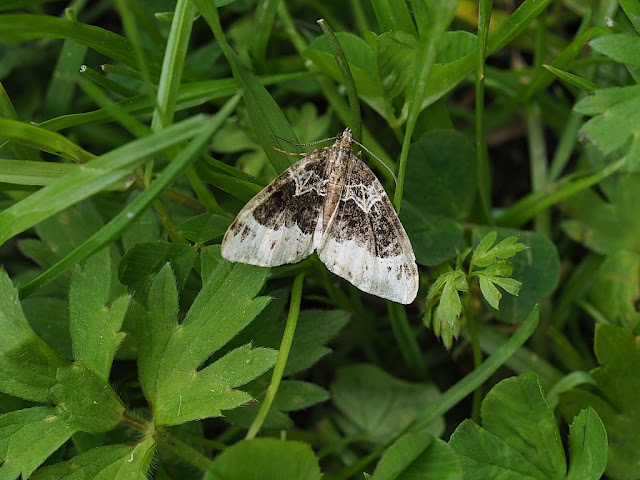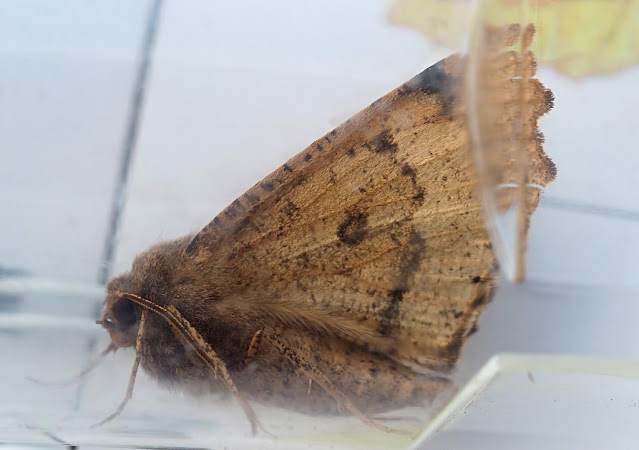Well, I was in Kirkwall anyway, trip to the tip, and getting a few supplies. NC had kindly invited me the day before when I mentioned I'd not seen Pale Brindled Beauty, I've never recorded one here, perhaps just a case of more effort required, but we don't have the range of trees and shrubs found in NC's garden. It is certainly a wacky looking larva.
 |
| Pale Brindled Beauty. |
Whilst there I phtographed Mottled Umber cats as well.
 |
| Mottled Umber. |
I didn't spend time hunting for hovers, although there are a few I haven't seen in the garden, a bit short on time, however, NC has very kindly invited me to return, and I might do so with a light trap as the Green Arches season is upon us, another moth I've not seen which occurs in her garden.
It's been a good week for moths with another new one, Anania fuscalis, flying in quite good numbers at Yesnaby on Monday. Yesnaby is a place to go to find day flying micros. This species has a rather vague status in Orkney, although apparently found a few times in South Ronaldsay.
 |
| Anania fuscalis. |
There were plenty of Eupoecilia angustana at Yesnaby too.
 |
| Eupoecilia angustana. |
And the first Large Heath of the year.
 |
| Large Heath. |
The Bonxie situation at Yesnaby, where they used to be common breeders, was disappointing, no birds on territory. There were six Arctic Skuas on territory but it looked as if only one pair might have been doing much.
I had intended to botanise a bit at Yesnaby and I did take photos of a couple of sedges, not identified them yet though. However, Heath Milkwort was a plant I was previously unaware of. I know Common Milkwort, and found that, but in checking in the book realised that there was another species that I might be able to find, five minutes later, success (as long as the ID is correct, of course).
 |
| Heath Milkwort. |
I also finally sussed out Sea Arrowgrass.
 |
| Sea Arrowgrass. |
Yesnaby is the only place I've found Carabus arvensis in the past, I wasn't disappointed this time as one duly obliged.
 |
| Carabus arvensis. |
During my wanderings I sadly found that the Short-eared Owls had lost one of their chicks. I found the body, not too far off fledging too. I'm guessing that the recent wind and rain meant they couldn't supply enough food. Happily, the adult posed nicely as I drove away up the road. I'm guessing they will have more chicks tucked away that have survived.
 |
| SEO. |
There were a couple of other casualties discovered on this outing. A dead whale, or bit of it anyway, probably a Minke, floating off the geo.
And Yesnaby being a mystical place some magic had been going on, bad magic.
 |
| Who beheaded the fairy? |
I've had the light traps out a bit, a few things caught. Unfortunately both my battery powered systems have failed. Looks like the inverter has packed up, and the other system is blowing fuses, the ballast has probably failed. A new inverter arrived yesterday so that ought to resolve that issue and the other system is going back to PB who'll hopefully diagnose and fix the problem, it was beyond my limited electrical skills anyway.
Thursday, I'd volunteered to help on a school trip to the beach for an ex-colleague. Give children catching implements and they'll usually turn up something of interest. Two new fish were a bit unexpected but excellent. Rock Goby and Sea Scorpion.
 |
| Rock Goby. |
 |
| Sea Scorpion. |
And the following day was our wedding anniversery, first time in the sea for the year and more sea creatures.
 |
| A paddleworm I think. |
 |
| Lenticular clouds. |



































